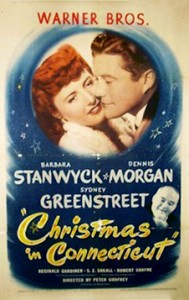“I hope I’m in time to see you flip the flapjacks.” — Alexander Yardley
Sure it’s fluff, this seasonal confection from Warner Brothers, this comedy-romance. It might be said that Christmas in Connecticut isn’t even good fluff. It has its diverting moments, though fewer laughs than might be expected considering the cast, and such eccentric-role stars as Una O’Connor, S. Z. Sakall, Reginald Gardiner and [intlink id=”1061″ type=”category”]Sydney Greenstreet[/intlink] are thankfully able, most of the time, to relieve the stickiness of the romance between [intlink id=”515″ type=”category”]Barbara Stanwyck[/intlink] and Dennis Morgan.
With comedy never a strong suit, hardly in the class with its swashbucklers, gangster flicks, women’s dramas or film noir, Warner Bros. was well into its decline by 1945, the slippage from its Golden Age never more evident than in the comedies. Christmas in Connecticut, then, falls short of the expertise so impressive in The Strawberry Blonde and that part-Christmas flick The Man Who Came to Dinner, both from 1941.
The mid-and late-’40s was, however, a better comedy time for other studios, at least in isolated instances. From 20th Century-Fox there was the endearing Miracle on 34th Street in 1947, and a neglected jewel in 1949 from RKO, Holiday Affair, about a young widow (Janet Leigh) being courted by two rather different men (Robert Mitchum and Wendell Corey), much as Stanwyck has to choose between her two distinct men. In both pairs, the preferred choice, both to the ladies in question and to the audience, is rather obvious and immediate, the outcome predictable.
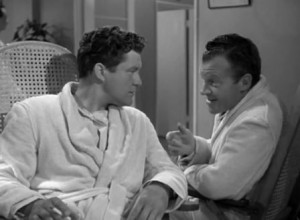 Throughout film history there have been numerous versions of the most often filmed subject of this particular season, Charles Dickens’ A Christmas Carol. Among the straight dramas, the satires, the musicals and the cartoons, the definitive version came relatively early, in 1951 with Alastair Sim’s immortal characterization of Ebenezer Scrooge.
Throughout film history there have been numerous versions of the most often filmed subject of this particular season, Charles Dickens’ A Christmas Carol. Among the straight dramas, the satires, the musicals and the cartoons, the definitive version came relatively early, in 1951 with Alastair Sim’s immortal characterization of Ebenezer Scrooge.
Christmas in Connecticut was being filmed during the closing months of World War II and released in the U.S. August 11, four days before Japan surrendered. The film has, understandably, the air of a war movie, dropping the viewer immediately into an action scene. A German submarine has sunk an American destroyer, leaving at least two survivors, Jefferson Jones (Morgan) and his buddy Sinkewicz (Frank Jenks). The movie is unconcerned about any other survivors, as the plot is really about food—well, food and romance!
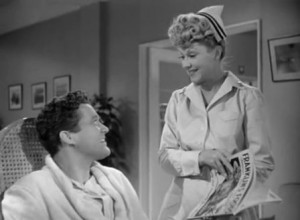 Floating along in a raft, Jones imagines his first meal ashore: “a big, thick, juicy steak, with baked potatoes”—not just one!—“asparagus with hollandaise sauce and chocolate cake and ice cream.” In order to acquire better food in the hospital, where he’s recovering from malnutrition after fifteen days on that raft, Jones takes Sinkewicz’ advice that he must flatter his nurse, Mary Lee (Joyce Compton). So well does Mary Lee respond to the “ol’ Magoo,” as Sinkewicz calls it, that Jones finds himself engaged.
Floating along in a raft, Jones imagines his first meal ashore: “a big, thick, juicy steak, with baked potatoes”—not just one!—“asparagus with hollandaise sauce and chocolate cake and ice cream.” In order to acquire better food in the hospital, where he’s recovering from malnutrition after fifteen days on that raft, Jones takes Sinkewicz’ advice that he must flatter his nurse, Mary Lee (Joyce Compton). So well does Mary Lee respond to the “ol’ Magoo,” as Sinkewicz calls it, that Jones finds himself engaged.
Meanwhile in New York, Elizabeth Lane (Stanwyck) is writing her regular cooking column, about her Connecticut farm with cows and all the other accouterments, and the lovely view from her kitchen window. The real view from, rather, her apartment window is the backside of the city, and, since she doesn’t know how to boil water, she gets her recipes from her friend and restaurateur, Felix Bassenak (Sakall).
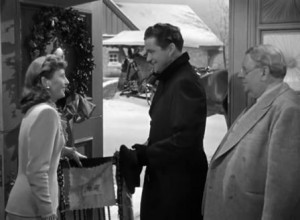 Trouble begins when her editor (Robert Shayne) announces that their publisher, Alexander Yardley (Greenstreet), wants to join her at her farm for an old-fashioned Christmas, since his daughter and granddaughter can’t visit him. Things are further complicated when Mary Lee writes to Yardley suggesting Mrs. Lane entertain a particularly lonely veteran—her new fiancé—for Christmas at her farm. Sensing a boost to his magazine’s circulation, Yardley thinks it a great idea. Since he is a stickler for honesty and would probably fire both Lane and her editor if he discovered she wasn’t a gourmet cook, they must come up with some scheme.
Trouble begins when her editor (Robert Shayne) announces that their publisher, Alexander Yardley (Greenstreet), wants to join her at her farm for an old-fashioned Christmas, since his daughter and granddaughter can’t visit him. Things are further complicated when Mary Lee writes to Yardley suggesting Mrs. Lane entertain a particularly lonely veteran—her new fiancé—for Christmas at her farm. Sensing a boost to his magazine’s circulation, Yardley thinks it a great idea. Since he is a stickler for honesty and would probably fire both Lane and her editor if he discovered she wasn’t a gourmet cook, they must come up with some scheme.
To begin, where to find a farm? Just so happens Lane’s stuffy suitor, John Sloan, has one, complete with snow. Since she’s married in her column, John (Gardiner; think of a slightly subdued Beverly Carlton from The Man Who Came to Dinner) can stand in for her husband and, as he has recently proposed and been accepted, the two can marry at the farm. And the baby she writes about? A neighbor’s will do.
When Jones arrives, it’s sparkly eyes from Elizabeth, eyelashes all aflutter. Standing at the door, she persists in salivating over him—and for the longest time. Or maybe it just seems that way. Thereafter, at least for the most part, any other nauseous symptoms subside into mere restrained adoration and planned proximity. Jones is equally turned on to her, but he’s hesitant, both because he’s engaged and because he believes her to be married.
The stage is thus set for multiple jokes on several situations already established. Nora the housekeeper (O’Connor) is forever mispronouncing Felix’s last name. Several times Sloan arranges for the local, befuddled judge (Dick Elliott, best known as Mayor Pike in The Andy Griffith Show) to perform the marriage ceremony but the plans are always thwarted by poor timing or unexpected arrivals. In a delaying ploy, Felix, who doesn’t like Sloan and believes Jones is the ideal man for Elizabeth, insists that the baby has swallowed his watch.
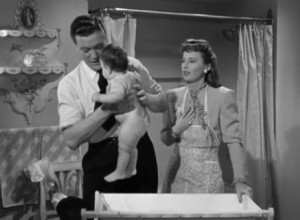 The baby is an endless source for humor. Jones, as part of his all-around “great guy” persona, knows all about babies, showing how to bathe and feed this one. Elizabeth is mistaken about the baby’s sex and when another mother brings her baby to the house in a swap, there is a curious change—a dark-haired girl becomes a blond boy. On one occasion when the mother is seen taking her child home, Yardley thinks it’s a kidnapping.
The baby is an endless source for humor. Jones, as part of his all-around “great guy” persona, knows all about babies, showing how to bathe and feed this one. Elizabeth is mistaken about the baby’s sex and when another mother brings her baby to the house in a swap, there is a curious change—a dark-haired girl becomes a blond boy. On one occasion when the mother is seen taking her child home, Yardley thinks it’s a kidnapping.
There are further diversions and confusions before the silliness is over. Since Morgan acquired his greatest fame as a vocal star for Warner Bros., Jones sings some Christmas songs, further charming Elizabeth. Jones and Elizabeth walk the cow to the barn. Yardley wants to see Elizabeth flip flapjacks, just as she described in her column, and though Felix tutors her, all doesn’t go well for her Christmas morning.
There’s a local barn dance and afterwards, in a runway sleigh, he and Elizabeth are arrested by two state troopers (one played by John Dehner). When Yardley discovers the charade, he fires Elizabeth but then rehires her when Felix lies that another magazine is attempting to acquire her talents. To round things off and make possible that long-awaited happy ending, Mary Lee knocks on the front door and announces she has married Sinkewicz, freeing Jones’ inhibitions. Elizabeth reveals she’s not really married to Sloan.
Many seasonal and popular songs are at the ready, both as source music and as part of the soundtrack, including “Jingle Bells,” “O Little Town of Bethlehem,” “The Wish That I Wish Tonight” and “Turkey in the Straw.” Although the main title credits the music to Frederick Hollander, the score consists of much stock music by Adolph Deutsch and Max Steiner.
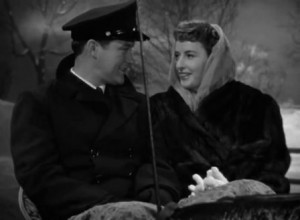 All the negatives and silliness considered, Christmas in Connecticut makes for a pleasant evening’s viewing should some of the more polished seasonal movies be unavailable. With a bowl of hot popcorn and some eggnog, it goes well with the season. The film is a snapshot of a time gone by, of another, more innocent age. It is a warm reminder of those slapstick movies of the ’30s and ’40s.
All the negatives and silliness considered, Christmas in Connecticut makes for a pleasant evening’s viewing should some of the more polished seasonal movies be unavailable. With a bowl of hot popcorn and some eggnog, it goes well with the season. The film is a snapshot of a time gone by, of another, more innocent age. It is a warm reminder of those slapstick movies of the ’30s and ’40s.
Christmas in Connecticut was the only truly Christmas movie of 1945, although there were others that included seasonal scenes or references to Christmas: Pride of the Marines, Dead of Night(British) and A Tree Grows in Brooklyn. One other film, The Bells of St. Mary’s, is the only one from 1945 that captures some of the spirit at least of the Stanwyck flick. Christmas in Connecticut was, in fact, remade for TV in 1992, with Dyan Cannon and Kris Kristofferson, and plans are underway for yet another version in 2013 with Jennifer Garner.
